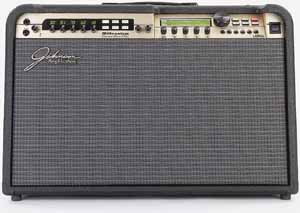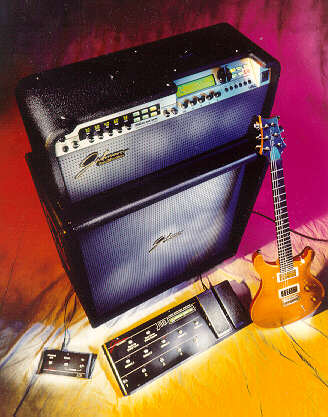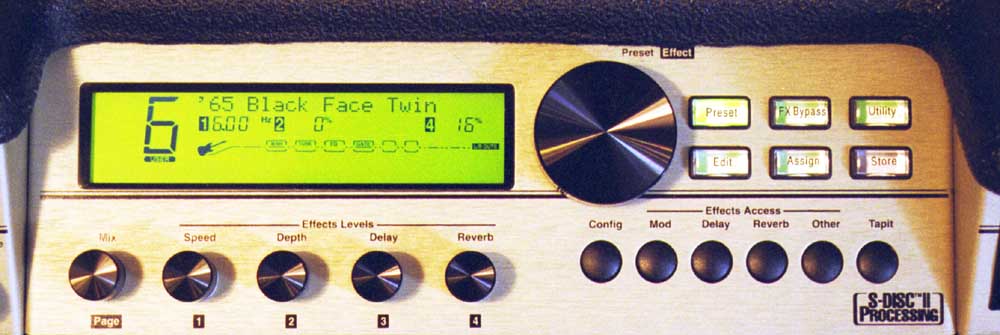

Harmony Central announcement of Millenium separate head and cab - Nov. 1997



Guitar Player review (local mirror saved) - Digital Dynasty: Five New Generation Modeling Amps. By Art Thompson. From Guitar Player, Dec. '99. Five digital amps. The Rocktron RepliTone and Yamaha DG80-112 receive Editors' Pick Awards.
See also DigiTech 2120 multifx preamp.
From spec at Harmony Central (can't find new location):
The Johnson Millennium Stereo One-Fifty packs a huge variety of classic amp tones (as well as new ones), combining true analog tube warmth with digital control and a state of the art effects processing engine. The Millennium is an amp at heart. All the familiar controls are here - treble, mid, and bass tone controls, contour, and gain, as well as input and output level controls. No menus needed. Feel free to turn those knobs as much as you like. The knob values are stored digitally. The amplifier models are grouped into categories such as "American Combo" (Fender Twin, Matchless DC30, etc.) and "British Stack" (Marshall). Each category has a button on the front panel. The characteristics of the tone controls change according the amplifier model in use (and if a knob wasn't present on the original amp, it will be disabled in the model.) The models also take advantage of the two real 12AX7 tubes in the preamp section. 16 different amplifier models to choose from, plus a number of custom Johnson voicings.This unit has top-notch FX processing too; see spec.
Emulated Amp Models
American Stack
- Dual Rectifier
- Boogie MK II
- Soldano SLO
American Combo
- '65 Black Face Twin
- '65 Twin - Bright
- Matchless DC30 1
- Matchless DC30 2
- Boogie MK II Combo
- Rectifier Combo
British Stack
- Marshall Master 1
- Marshall Master 2
- Marshall JCM800
- HotRod Marshall
British Combo
- '63 AC30 Top Boost
- '63 AC30 Top Boost Dirty
- Marshall JCM800 Combo
The Johnson Millennium packs plenty of power for gigging with 120 watts RMS per channel into four ohms (60 watts into eight ohms.) If necessary, you can easily add external cabinets to the Millennium with the speaker jacks on the back panel. You also have the option of going direct with the stereo XLR outputs which features a speaker cabinet emulator. When going direct, you can disconnect the speakers if you are worried about disturbing your neighbors.
Johnson Amplification also offers a 250W stereo head (JM250H) and accompanying 4x12 and 2x12 cabinets (J412V and J212V respectively.) A smaller 100W stereo combo - the Johnson Marquis - is also available.
Two 12" Celstion Vintage-30 Speakers
200 Patches - 100 Factory, 100 User-programmable
Johnson Amplification
8760 South Sandy Parkway
Sandy, Utah, 84070
(801) 566-8800 (Voice)
(801) 566-7005 (Fax)
Has there been any discussion of putting a saturated power tube in the effects loop of the Johnson Millennium? [I think the loop on this unit is too early, before the distortion stage.] I used this approach with the 2101 processor and it was a complete success. There are many products that enable power tube saturation quietly. If you put any of these products between the Millennium's distortion stage and time-based effects stage, then you have added the most important component required for the Tone equation: a saturated power tube. This provides the dynamic sponginess that is missing from all amp emulators which lack a power tube. No matter how good the preamp voicing and speaker simulator EQ is, it only sounds like an equalized preamp. The only way, so far, to really capture tube *power* amp saturation is to include a power tube such as an EL84 between the preamp distortion stage and the final amplification stage.
For their next generation of gear, DigiTech should include an EL84 and load in between the distortion stage and time-effects stage. This is the ideal sequence:
o Eq, compression, distortion, eq
o Low-watt power tube, load
o Eq, speaker simulator
o Time-based effects
o Solid-state high-power amp, speakers
I put a Fender Pro Jr. 15 watt tube amp, speaker isolation cabinet, and mic into the effects loop of the 2101 multieffects/"preamp" unit. Another user, in response to my suggestion, reported complete success in putting the ADA Ampulator in the effects loop, capturing the dynamic sponginess that is the signature of power tubes, as opposed to preamp tubes.
Preamp tubes are of relatively zero signficance, compared to power tubes. Don't be fooled by marketing and cost-cutting measures. There is a world of difference between so-called "preamp tube warmth" and power tube dynamics. I am impressed by the accuracy of the amp simulations in the Millennium and its competitors. But there is a glaring ommission that prevents these equalization-tweaked units from sounding authoritative: power tube dynamics are utterly lacking. There is no reason for this; it would be fairly straightforward to insert an EL84 in the effects loop. Other companies have already done this, in one form or another, such as the SWR Interstellar Overdrive, the Warwick Quadruplet, and the H&K Cream Machine.
Would someone please try this approach with the Millennium and report on the results?
________
>If we want to get to the nitty gritty, Let's not forget the dynamics of the loudspeaker and output transformer that interact with the power tubes. These are equally important in the equation!
These factors are indeed important, and I discuss these in my Amp Tone site. That is why I prefer to place not only a saturating power tube and dummy load in the effects loop, but also a hard-driven guitar speaker and mic. While the Ampulator *did* give power-tube sponginess that the 2101 could never provide on its own, I feel that an even better Tone was achieved by my use of an actual hard-driven speaker as well, in the processor's effects loop.
To go further, someone pointed out the need for *multiple* hard-driven guitar speakers, and for room resonance. An amp isolation booth achieves the former, and post-power-tube digital reverb achieves the latter.
>Johnson tries to cover all of this with their "Harmonic Feedback" circuitry that is supposed to emulate the "warmth" of a power tube. And this they couple to a pair of Celestion "Vintage 30's".
It's very good that the designers and users have discovered the real, specific goal -- not just to sound like any ol' tube, such as a 12AX7, but specifically, to sound like a *power* tube. This is a step forward in awareness in the field. And using the Vintage 30's is also a good sign of respect for the importance of a genuine, actual, hard-driven guitar speaker.
So at least they are *trying* to emulate the "warmth" of a power tube. They have not succeeded. Put a real saturated power tube in the effects loop, to demonstrate my point. Do the current units sound overly squashy, spongy, with an excess of power-tube saturation? Any simulation that works should be able to move from the tight sound of 6550's to the squashy sound of EL34's, and keep going into the realm of ridiculously squashy, saturated tone. They cannot do this; the simulation isn't really effective. The term "warmth" is misleading and a false goal -- designers think they can just equalize this sound into existence, but they can't, because the signature quality of power-tube saturation is not simply warm equalization, but rather, spongey dynamics and borderline, smooth breakup.
>Any closer to the real thing and you are no longer talking about an amp "simulator".
That's just a matter of definitions. There are various approaches to simulating. And what are we simulating? Not a VOX with any ol' settings, but a *cranked* VOX, and *cranked* Fender -- this, today's simulators (that lack a *power* tube) cannot do. I propose using a quiet, low-watt tube amp to simulate the sound of various loud, cranked tube amps.
>How does one make an EL85 sound like a 6550, 6L6GC, etc.?
The saturation response of various power tubes in various configurations varies, and it would be impossible for an exact simulation of a 6550 using an EL84. But the designers could do a good job of this, the same way one tries to make preamp tubes and DSP and distortion voicing in one amp sound like a VOX and Fender and Marshall and Boogie -- by faking it through EQ, plate voltage, and anything else you can think of. It makes sense to start with some particular power tube, when trying to emulate a variety of power tubes. If an EL84 were added to the existing great preamp and speaker response simulations, the result would be that much closer to these classic (cranked) amps, because *some* degree of power-tube saturation would be present, rather than none.
While the simulators strive to achieve the sounds of classic amps, some amp companies such as Groove Tubes and Mesa/Boogie make it their specialty to support multiple power-tube configurations in a single unit. For example, Class A - Class A/B switching, half-power switches, and damping factor. These designers are pushing the envelope of varieties of power-tube dynamics. An EL84 in various configurations can't exactly mimic all possible types of power-tube response, but it's a great start. Read the reviews of the low-watt power tube units at my site -- users *love* these power-tube saturation devices and swear by their dynamic sponginess. A new era of guitar gear is upon us, with various combinations of cranked-amp emulation and low-watt power tubes.
As good as the Millennium and 2120 and competing products are, they all blatantly lack *the most* important Tone factor: the dynamic sponginess of a saturated power tube. That is what guitarists want most of all, and that is what the fewest companies are providing. What few products there are are getting rave reviews from users, who are finally satisfied, and are all surveyed at my site. I asked Digitech to include a saturated power tube in their processors, quiet clearly and emphatically, two years ago. Developments since then have proven me right, and I still strongly urge Digitech to try sticking an EL84 between the distortion and time-effects stages of all their gear -- *if* they want to stay ahead of the competition. For all the flexibility of Digitech's current gear, which I highly respect, there are many guitarists who would rather have a Lawbreaker or Crunchmaster, with limited flexibility but with true, genuine, authoritative Basic Tone. Until designers combine a low-watt power tube with multifx flexibility, guitarists will have to combine products from separate companies, as I have described at Amptone.com.
user comments - in short, users say it has fairly convincing emulations, perhaps 80% successful (combined with awesome, top-notch flexibility). These comments are so excited about ease-of-use, I here excerpt a couple critical ones having to do with Basic Amp Tone:
I was actually happy for a few days until I went to jam with a friend who had just purchased a Mesa Tremoverb. Damn thing blew me away, the one tone, excited me more than anything in the Johnson. Most processors are pretty easy to work into your rig...that is, you can get good sounds from them. But that BASE tone--the one you can rely on in battle--has to come from a single amp built for it. [my term is "basic Tone" - Michael] No amp can currently do everything to complete satisfaction. So I've decided to look for a tube amp (traded the Johnson in for the Marshall JCM 2000) that has that one clean/distorted tone that blows me away. From there, I'm pretty easy to please when it comes to adding FX. The Johnson is a great amp in its versatility and convenience, but I wouldn't take it into battle with me....
I am VERY picky about my tone. Almost everyone agrees that old Plexis, Voxs, Fenders, Boogies, Soldanos, Riveras, Matchless's, etc. offer amazing 3-D tone. If you're a "no effects" tube amp purist kind of player you're not going to like this amp. Some amp models are good, some aren't. I think 90% of the factory presets suck. They're harsh and brittle and buzzy. They sound like cheezy processor presets. However, like the Roland VG-8, if you take some time to explore the presets and the processing options, you can dial in some VERY cool tones. None sound exactly like the amps they're supposed to emulate. They're not as detailed, harmonically rich, punchy or just plain "there" like the real deals. But they're still damn good! Running the Millennium in a live band situation makes it almost impossible to tell the difference between it and the "real" amp it's emulating. It's that good. If you simply cannot live without the "real" amp, the Millennium is not for you. If you want great amp simulations with unlimited effects routing configurations for combining, morphing, mutating etc. This is the amp for you! It's a serious tool for those who like a variety of quality amp tones and effects. If you're a serious guitarist in a cover band or you simply crave a wide variety of amp characters beyond the clean, crunch, lead range, this is a KILLER amp! It really does change "character" from one amp model to another. It has great Vox, JC-120, Dual Rectifier, and thrash-metal tones. The stock Marshall tones suck but with a little tweaking sound great. I dialed in a great early Van Halen tone, even with single coils, complete with that super rich Phase 90 sweep! The Matchless tones sound "boxy" to me. They have a honky midrange which reminds me of a Rockman. You also can't tweak the mid's on them from the front panel on the Matchless models -- you have to use the internal EQ's. On the other hand the "Johnson" amp models sound pretty awesome! There's a realistic Eric Johnson lead tone a la "Cliffs Of Dover", some great blues tones, and a couple that sound like a 335! The "Johnson" amp models seem characterized by a smooth midrange EQ. It's interesting to note that all presets have noise gates so even if you're totally cranked up with a brutal Pantera thrash tone the amp is unnervingly quiet until you hit a chord, then the room explodes! The whole vibe of the Johnson Millennium is that it feels "different". Not bad, just "different". It takes a little getting used to but is definitely the coolest combo amp I've played thru. If you like to tweak, you'll love it! If you want to turn it on and expect every tone to be "there" you'll be disappointed.
I believe there will be better emulation amps to come (they will receive a 9). I don't know if there will ever be an amp which uncompromisingly does everything perfectly but I'm hopeful. I also like the tone and definitely the feel and presence of my current "big" system which consists of: Hughes & Kettner Access Preamp, Mesa Boogie Stereo 2:90 Poweramp, Rocktron Intellifex, and Digitech DHP-55 Harmonizer thru Marshall 4x12s. For a portable all-in-one combo amp it's hard to beat the Millennium. I haven't heard anything better although Rocktron just introduced their version of the Swiss Army amp and it's supposed to be great. I chose the Millennium over the Axsys Line 6, ART 830 & 825, and Peavey Trans-Fex on the basis of tone, feel, versatility, and number of usable & interesting features. I don't know if I'd buy it again simply because it isn't replacing my main rig and also because I don't think emulation amps will stand the test of time. But I've been playing guitar for 28 years and this is the most authentic jack-of-all-trades amp I've ever heard. Just bear in mind that, unlike the amps it emulates, it is a master of none.
Now, the big question: how good is this amp at simulating Marshall, Mesa, Fender, Vox, Matchless, & Soldano? I don't know as I haven't had the opporunity to park the Millennium side-by-side with these amps. The Mesa Rectifier model does have the very familiar crunch to it (my favorite), and the Matchless also has the typical grind - the others sounded pretty generic to my ear. I evaluated this amp not from the perspective of its ability to recreate these amps (in my opinion, if you want a Marshall sound you buy a Marshall amp), but rather as a vehicle to create a variety of high quality guitar tones. In that regard I wasn't very impressed. To my ears the tone was always pretty synthetic - the type you expect when you plug into a digital preamp like the RP-12, GT-5, Zoom, etc. My first experiments were with the presets, then I started to tweak to find a more natural sound. Although I did come up with some interesting & inspiring stuff, I was unable to create an "earthy" feel to it.
I found the stock, basic amp emulation tones to be quite sterile and synthetic. I'd rather invest in an amp that does a couple tones extremely well and then complement it with some nice outboard gear. This amp is great in that it has a lot of versatility housed in a relatively compact package, but I was unable to get it to sound right for my ear.
I wish this were available as a rack mount preamp/multifx configuration, with no amp or cab.
Official Johnson products page
Click these custom links to find the latest information and discussion about this product.
Article at Harmony Central (not found)
user reviews for this manufacturer at Harmony Central
product news for this manufacturer at Harmony Central
search newsgroup postings at Deja.com
Amptone.com ultra gear-search page